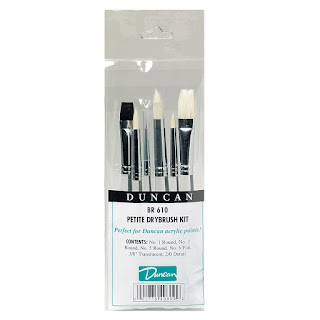How To: Drybrushing
Drybrushing is a technique using a somewhat stiff, dry, round-tipped brush. The brush is dipped in an opaque acrylic colour and then any excess colour is removed from the brush’s bristles by wiping it out of the brush onto old blue jean material (or similar material such as a paper towel or piece of cardboard) until the brush feels almost dry. After the basecoat is applied, (and if required, antiqued) the desired areas are drybrushed by painting with a soft back and forth motion until there is an even, blended coat. If the paint from the brush gets into the crevices of the detail, not enough colour has been removed from the brush. If this is the case, simply remove more of the colour from the brush by wiping more colour out on the blue jean material. If the piece has little or no detail, leave more paint on the brush to speed up the process.
Helpful Hints for Drybrushing
- ALWAYS use a drybrush
- Do not dip the drybrush in water or clean it until the section is complete
- Use the same brush when going from one colour to another of the same hue (example: Chocolate Fudge, Chocolate, Medium Mocha, Light Umber, and Buttermilk). Go from one colour to the next by wiping the colour out of the brush on a piece of material as before. This will help the colours blend for a more natural look
- Always use the appropriate-sized brush for the area being painted
- When the brushes wear out, throw them away or use them for other purposes. It is important to have long enough bristles to create the soft, even effect that makes drybrushing so appealing
- Do not be too rough when removing excess paint from the brush. The brushes will last much longer if the paint is wiped out gently
- Everyone drybrushes differently to some extent, and colours will vary even though the same colours are used. This is due to different amounts of colour on the brush and coats applied
- Remember not to get discouraged if this is your first attempt at drybrushing. This type of painting usually doesn’t look finished until the final steps are completed and all of the details are added
How to Apply the Basecoat for Drybrushing
The basecoat is the opaque, acrylic water-based coat of paint applied to the ceramic bisque sing a mock sable shader or an airbrush. Some instructions call for different colour basecoats on the same piece or for the entire piece to be base coated one colour. Use the appropriately sized square shader for the area. This coat of paint is applied as smooth as possible, leaving no lumps, bumps or ridges. Do not leave any bisque unpainted unless the next step is for the same area to be antiqued. In that case, the antiquing will cover any bits of unpainted bisque. For achieving the best results, especially on large areas, use an airbrush.



Comments
Post a Comment